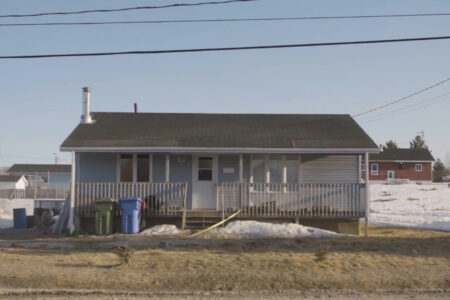
It is fascinating to watch local television when you travel to foreign countries. But often the programming is incomprehensible to the visitor, because of a language barrier, but also because of different cultural references and a different understanding of society. Imagine if you felt like this in your own country, if the country of your birth, your reality, your way of being, was not reflected in the media and was in fact replaced by a foreign set of values and perspectives. This is how the indigenous peoples in Canada felt about the onslaught of television.
Aboriginal people have been portrayed as villains, vanquished or vanishing. There’s the drunken Indian on the street; the Indians who are always on the losing side in the battle with John Wayne; or the stoic, traditional Indians, portrayed as quaint anthropological oddities whose culture had to be quickly preserved in museums because it was ”dying out.” And I might add one more: the ecological saviour, which includes the all-wise elder who is at one with the land and laments the destruction of mother earth. As with all stereotypes, these ones have been difficult to dislodge from the mainstream Canadian mindset. But attitudes are slowly shifting, and that is partly due to the existence of the Aboriginal Peoples Television Network (APTN).
APTN was born from the desire among Aboriginal people to tell their own stories, to counter the negative — or nonexistent — portrayal of indigenous realities. When early satellite experiments were carried out in Canada in the 1970s, the Arctic was seen as a perfect testing ground because of its remote location and extreme temperature. If the satellites could work up there, they could work anywhere. And so northern communities that were virtually untouched by mainstream society and culture suddenly received an onslaught of foreign images and stories, as Inuit leader Rosemarie Kuptana described it.
An unintended consequence of the introduction of satellite technology was the speed at which Inuit and other northern Aboriginal people quickly took advantage of this new way of telling stories and began using the media to their advantage. The Naalakvik and Inukshuk projects put video cameras and equipment into the hands of eager Aboriginal people, and they quickly adapted to the new technology.
The creation in 1983 of the Northern Native Broadcast Access program, through the former Department of the Secretary of State, allowed northern nonprofit communications societies to broadcast their own programming, in their own language, following their own format, on any topic they deemed important. The result was an eclectic mix of howto hunting videos, community consultation discussions, a children’s puppet show and language instruction. Television Northern Canada (TVNC), created in 1992, was a distribution system that provided a much-needed medium for northerners to view all of this eclectic programming. But there was no stable government funding for the communication societies or for TVNC. They looked longingly at southern Canada, with its vast population and wealth. That was how TVNC was going to survive.
Today, children on tiny reserves can choose a career in television.
After much lobbying, fighting, arguing, cajoling and manoeuvring, TVNC got a national television broadcast licence from the Canadian Radio-television Telecommunications Commission (CRTC). The new network was called the Aboriginal Peoples Television Network. It was launched in September 1999 with much fanfare across Aboriginal Canada, and it was viewed with indifference by most Canadians and with hostility by many cable companies and existing TV networks, which disagreed with making all Canadians pay for a service with exclusive Aboriginal programming.
The network started out small; in fact, apart from the existing TVNC programming, there was only one original series. It was called Cooking with the Wolfman, and it still airs on APTN today. Since then APTN has won numerous awards, branched out into news and current affairs, drama, sports and coverage of live events. Based on the sheer amount of programming, APTN has been a success.
But as APTN prepares to appear before Canada’s broadcast regulator to ask for a seven-year renewal of its licence, it is a good time to ask what the network has accomplished in its 14-year history. What can be learned from a policy perspective?
When APTN launched in 1999, the television production community — the producers, directors, writers, actors, camera operators and all the other technicians required to produce television — was virtually nonexistent in the Aboriginal world. Young Aboriginal people were not flocking to these kinds of jobs, because there were few opportunities. APTN changed all that. Today, children on tiny reserves and in communities across Canada choose a career in television, knowing that there is a place for them.
Because APTN receives subscriber fees, it has a stable revenue base. This also means that the network is attractive to other broadcasters and other non-Aboriginal producers. There are stories of Aboriginal producers and directors who, prior to APTN, had great difficulty getting their stories to air or who were not allowed to produce their vision in its entirety without interference or editing by mainstream networks. Today, many producers are looking to partner with Aboriginal producers in order to gain access to the APTN market. And APTN is now being approached by regional, national and international broadcasters to partner on developing new dramas or series.
You can find top-notch programming on APTN, as good as or better than what is seen on mainstream networks. Wapos Bay is an entertaining claymation series for children that teaches traditional values. Blackstone is a gritty drama about an all-too-real fictional reserve. The comedy series Caution: May Contain Nuts appeals to a wide audience and has a loyal following. The quality of the programming is winning over new viewers, while also ensuring that they see a true, even if flawed, portrait of Aboriginal people in Canada. Being depicted as real, if flawed, is better than being depicted as a stereotype.
The level of discourse across Canada on Aboriginal issues has been increased since the advent of APTN. Before the network existed, while other networks would pick up Aboriginal stories if they directly affected the lives of Canadians, there was very little coverage of Aboriginal issues in mainstream media. Every few years, the CBC or other networks would dedicate some time and resources to programs such as All My Relations or Absolutely Canadian, but few have been long-lasting. APTN continues to delve into the issues that affect Aboriginal people, and it has thus provided a forum for Canadians to learn about the history and reality of First Nations, issues such as residential schools, the Indian Act or the crisis situation on reserves like Attawapiskat. APTN broke the story in 2011 about Bruce Carson, the former aide to Stephen Harper, who was charged with influence peddling, and other networks followed suit.
By helping to nurture Aboriginal media professionals who move on to other television networks, APTN is improving the calibre of discussion about Aboriginal issues in Canada. Duncan McCue or Waubgeshig Rice, for example, are journalists with the CBC. They report on diverse issues, but when they do report on Aboriginal issues, they are able to provide a particular context and awareness that would probably have been lacking in the past. Or look at the actors Adam Beach and Lorne Cardinal. Adam admits that in the past he was always typecast into stereotypical roles. Now, looking at his recent list of credits, he has played a cop and an airline pilot. And Lorne Cardinal, on Corner Gas, played a police officer whose job or role was not tied to his ethnicity. This is progress, and APTN has played a role in that.
APTN provides a unique perspective that should be welcome in our multicultural country. Its coverage of the Idle No More movement, for example, is a counterpoint to that of other media networks. Its covering of Olympic events in the 2010 Vancouver Games in several Aboriginal languages was groundbreaking and unique. The Aboriginal Peoples Television Network is a service we can be proud of.






